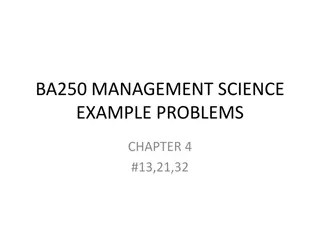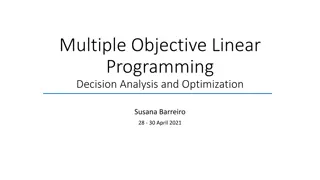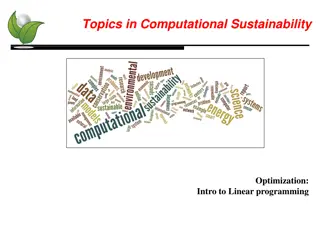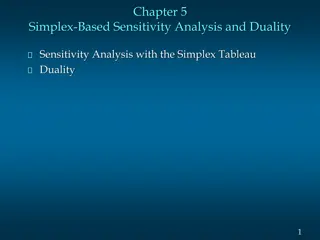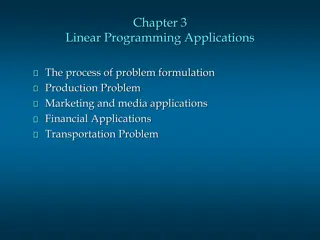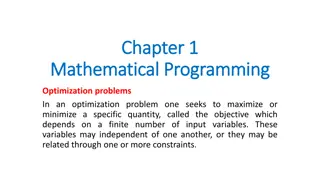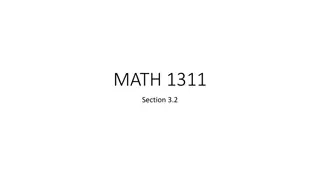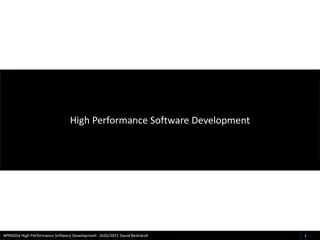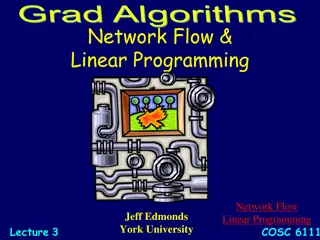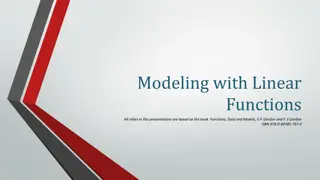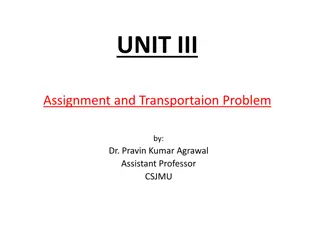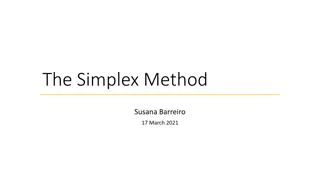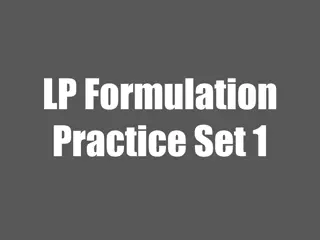Introduction to Optimization Models in Linear Programming
Optimization models in linear programming involve defining an objective to maximize or minimize, along with constraints that must be adhered to. Decision variables impact the objective, and the optimal solution satisfies the constraints while achieving the best outcome. This process is crucial for making informed decisions and maximizing efficiency in various real-world scenarios, such as production planning and profit maximization.
Uploaded on Oct 07, 2024 | 0 Views
Download Presentation

Please find below an Image/Link to download the presentation.
The content on the website is provided AS IS for your information and personal use only. It may not be sold, licensed, or shared on other websites without obtaining consent from the author. Download presentation by click this link. If you encounter any issues during the download, it is possible that the publisher has removed the file from their server.
E N D
Presentation Transcript
1 Optimization Models Mathematical optimization models usually contain an objective (what to do) constraints (the rules that must be followed). Also referred to as programming models Example objective: maximize profit for the week ($150 per unit). Example constraint: maximum of 40 hours for production (each unit takes 8 hours).
2 Model Inputs Controllable inputs are those over which we have influence (in this case X), and are also referred to as decision variables. The decision alternatives are the different values for these inputs or variables. The optimal alternative is the set of input values that is feasible (i.e. satisfies the constraints) best meets the objective Uncontrollable inputs are those over which we have no influence
3 Modeling Example CrossChek would like to set up displays in some of its retail stores for two new lines of hockey sticks. The company has designated two employees to work on setting up these displays, with employee A having up to 12 hours available and employee B having up to 8 hours available. They need to figure out the optimal number of stores in which to set up each display. It is expected that each display of the first stick will bring in $3K in new profit, the second $2K It takes employee A 4 hours to set up each display for the first type of stick Each display for the second type of stick requires 1 hour from employee A and 2 hours from employee B.
4 Linear Programming This particular model is a linear programming model, or linear program. A mathematical model in which the objective and the constraints are described using linear functions (functions in which each variable appears in a separate term and is raised to the first power. A function with n variables will create a line in n-dimensional space). Programming is not meant in the sense of computer programming, but rather that (optimal) decisions must be made within the model. Thus the act of describing and solving a decision problem with linear objective and constraint functions is referred to as linear programming.
5 Back to CrossChek Manufacturing Consider two high-end hockey sticks, A and B. $150 and $200 profit are earned from each sale of A and B, respectively. Each product goes through 3 phases of production. A requires 1 hour of work in phase 1, 48 min in phase 2, and 30 min in phase 3. B requires 40 min, 48 min and 1 hour, respectively. Limited manufacturing capacity: phase 1 1000 total hours phase 2 960 phase 3 1000 How many of each product should be produced? Maximize profit Satisfy constraints
LP: Production Planning Three products P1, P2, P3, two machines M1 & M2. Machine capacities: 8 & 9 hours, respectively. The products sell for $20, $15, and $17, respectively. Production costs: M1: $120 per hour, M2: $90 per hour. Processing times of the products on the machines (minutes): M1 M2 P1 3 6 P2 5 1 P3 4 3 Need to maximize profit
LP: Employee Scheduling Allocate employees to shifts. Shifts start every four hours at 0600 hrs, 1000 hrs, 1400 hrs, etc. Each shift lasts 8 hours. Minimize the total number of employees required. Personnel requirements during 4-hour time slots: 0600 1000 1000 1400 1400 1800 1800 2200 2200- 0200 0200 0600 Shift Minimum required number of employees 17 9 19 12 5 8
8 LINDO Windows software for solving linear programming models http://www.lindo.com/ Download and install Classic LINDO Select Demo Version when prompted
9 LINDO Two sections: Objective Prefixed with Maximum or Minimum ( Max or Min ) Constraints Prefixed with Subject to ( st ) Operators: Only +, -, <, > or = Not case sensitive Once the model is entered, click the Solve menu, then the Solve command
10 LINDO Input
11 LINDO Output Objective function value given The optimal value of the objective function Solution given Under the VALUE heading for each variable Ignore everything else for now
12 LINDO Output






